But with so many tools and services available, how do you know what your sales team really needs? Below, we’ve covered 10 of the most useful types of sales tech, along with what they do and why you’d need them. But first, let’s start at the top…
Table of Contents
- What is sales technology?
- What does sales tech stack mean?
- Sales Technology Benefits
- 10 Types of Sales Technology
You might sometimes see the term “sales tech” confused with “sales automation” or “sales enablement,” but these aren’t the same thing.
- Sales automation is the process of automating certain steps in your sales funnel. It’s an outcome of using sales tech.
- Sales enablement is the process of providing your sales team with the resources, content, and information they need to increase sales. It’s the goal of using sales tech.
In the post-pandemic world, it’s not enough to have a tech stack that only works on-site. With 63% of sales teams either fully or partially remote, according to recent HubSpot data, your sales technology must be as easy to use offsite as it is on.
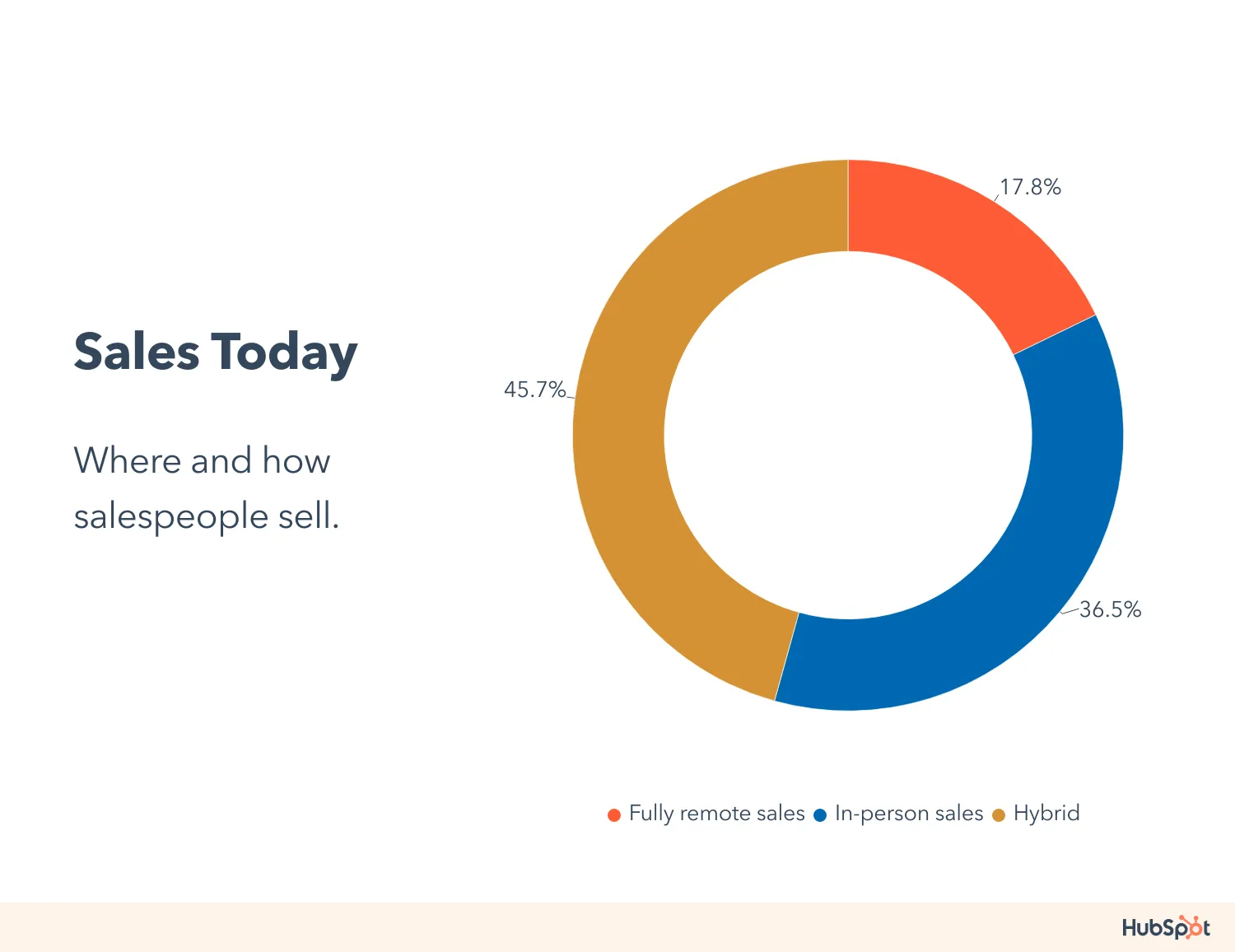
So, what does a “normal” tech stack look like for remote-enabled teams?
According to Dan Gottlieb, senior director analyst in the Gartner for Sales Leaders Practice, “The average virtual selling technology stack includes 13 technologies.”
However, with Salesforce data showing that two-thirds of sales reps feel like they’re drowning in tools, it’s a good idea to look for sales technology that condenses as much functionality as possible.
Moreover, it means that it’s more important now than ever to be sure that every tool in your sales tech stack integrates smoothly through native integrations or a custom API to minimize manual workarounds.
How to Build the Best Sales Tech Stack for Your Team
While there is no single best tech stack, you can build the best sales tech stack for your team. This means you need to understand your team’s top priorities and what sales tools can best aid them in achieving their goals.
So what are those goals?
HubSpot recently asked 516 B2B and B2C sales professionals to name their top three sales goals.
Across the board, the number one goal was exceeding sales targets.
This isn’t particularly surprising when you consider that commission plays a significant role in compensation for the vast majority. Nearly half (48.8%) of sales organizations use a base salary plus commission model, with another 25% using a salary plus bonus model.
And while B2B and B2C do have different priorities, by looking at the chart above, you can see how closely aligned they are across the board. Rounding out the top five goals:
- Making the sales process more efficient
- Upselling or cross-selling your existing customers
- Winning more market share
- Improving sales and marketing alignment.
Again, while none of this is particularly surprising, it’s important to understand what your salespeople want most so you can build the sales tech stack they need.
Sales Technology Benefits
Now that you understand what sales technology is, how your tech stack can support your team, and what your team wants, let’s explore some of the biggest benefits of sales technology.
1. Get real-time data and actionable insights.
Making data-driven decisions has long been one of the biggest benefits of sales technology. Most tools are able to gather and report on the most important and commonly requested sales data right out of the box. However, because each business may need to track slightly different metrics, many can be configured for custom datasets and reports.
And the data you can access is getting even better as AI emerges as a huge power player in sales technology. Instead of downloading monthly reports and finding out what your customers needed weeks ago, AI-enabled tools get you access to real-time data so you can meet your audience where they are right now.
Better yet, by automatically combing through the data, AI can do in minutes what might have taken humans weeks or months to do, generating insights you can use to make quick decisions like:
- Reaching out to customers who have questions on products, either serving them better or upselling them on new products.
- Identifying new search patterns or trends and tailoring offers to them.
- Discovering common questions and aligning sales and marketing teams to answer them.
- Finding drop-off points in the sales process and working to circumvent them.
- Personalizing your content to clearer personas and audience segments.
2. Respond quickly to leads and close more sales.
A rock-solid tech stack can make sure you get to leads more quickly and effectively. Here’s why that matters.
According to SuperOffice, 46% of customers expect a response within 4 hours, and 12% want one in under 15 minutes. Moreover, 78% of customers purchase from the first company to respond.
And, with an overall average lead response time of 42 hours, there’s a great deal of opportunity to gain a competitive advantage and close more sales. That makes a top-notch tech stack that allows your team to respond quickly more than “just a good idea.” It’s absolutely vital if you want to deepen your market share and start building a strong relationship with your prospects.
One way you can do this is to create chatbots for your website and social channels that make it easy for customers and prospects to find the information they want and route them to real team members when they’re ready for human interaction.
3. Automate time-consuming busy work.
One of the drum-beats of digital transformation and technology modernization is improved efficiency across the board due to automation, which can cut out half of your work activities by reducing “busywork” types of tasks.
Did you know that currently, sales reps spend less than 30% of their time actually selling? While there are many factors that go into this, one of the most significant lies in the sheer number of tasks required as part of their job.
.webp)
A great sales tech stack can free them up to focus more on sales, eliminating tasks like:
- Data entry
- Manual data transfers and manipulation
- Prospect research
- Data insights
What’s more, your sales tech stack can take the pressure off remembering to follow up with leads at certain intervals by automating the follow-ups themselves or simply sending reminders to your team.
4. More easily generate and qualify leads.
Your sales tools give you critical data that makes it easier to align sales and marketing teams. Some of the results might include agreeing on the same data-backed goals, aligning on specific personas and key products, and working together toward goals instead of taking conflicting or incongruent actions.
Additionally, these sales tools make it possible to create campaigns that target your personas based on their specific problems and generate highly qualified leads that your sales team can nurture.
5. Gain a competitive advantage.
It’s not just responding more quickly to leads that delivers a competitive advantage. The right sales tech can give you insights into your entire pipeline, delivering detailed information about what your audience wants and needs.
And it’s not just about getting the sale the first time. It’s also about keeping them. There are a few important things to know here about happy customers:
- They stick around, which creates higher ROI because new customer acquisition costs about 500% more than retaining current customers.
- They’re more likely to buy other products from you through cross-selling, upselling, or even seeking you out for new solutions, which can increase your sales and profits by 20% and 30%, respectively.
- They improve your brand reputation and increase the trustability of your brand, which is an important factor for 81% of new customers.
- They give positive reviews of your products and services, which makes 72% of prospects more likely to buy.
So, how does your tech stack deliver on keeping your customers?
Because it enables you to respond quickly to questions and personalize the content and sales process, it starts the relationship on the right foot. By helping you stay on top of their experience with periodic follow-ups, you can quickly identify opportunities for upsell or service.
If service is needed, you can quickly route and seamlessly share data and observations with your service team.
6. Improve sales process efficiency.
What do all of these benefits have in common? Increased effectiveness and efficiency of your sales team, which, after all, is one of the top goals of sales professionals.
Ten Types of Sales Tech You May Need
1. Customer Relationship Management (CRM) .webp) Get Started With HubSpot’s CRM
Get Started With HubSpot’s CRM
What it is: At its most basic, a CRM is software that organizes all of your interactions, communications, and data about your customers. That means tracking all purchases, payments, quotes, calls, emails, chats, and agent notes in one place.
But a CRM isn’t just a database. It acts as a dynamic dashboard that lets you track leads across the entire sales lifecycle (and beyond).
Many CRMs go even further, using the data to give insights like lead scoring, segmentation, forecasting, and sales reports.
Why you need it:
- Provides a single source-of-truth for customer data to your sales, marketing, and service teams.
- Removes the need to manually track calls, emails, chats, etc.
- Allows sales agents to quickly access a customer’s sales activity and purchase history.
- Gives you the ability to scale your sales processes.
Good vs. Great: A good CRM will automate the collection and organization of your customer data. A great CRM will act as a platform for your other sales tech, integrating all of your business data in one central location.
Examples
2. Sales Prospecting Tools
.webp)
What it is: Prospecting tools are software that automate the process of finding and qualifying leads.
Some prospecting tools do this by gathering information about visitors to your website. Others pull demographic data from social media sites like LinkedIn or Twitter. Still, others build an internal database by scraping public and private data.
You can then sort and filter these potential leads by whatever criteria are important to you — company size, geography, behavior, etc.
Why you need it:
- Eliminates the need to manually hunt for prospects (and their contact info).
- Discovers prospects you may not have considered otherwise.
- Flags engaged leads by behavior (such as website viewership).
Good vs. Great: Good prospecting tools help you build a prospect list, complete with contact info. Great prospecting tools use AI to unearth similar leads based on your ideal customer profile.
Examples
- HubSpot Sales Leads (included in Sales Hub free and above)
- LinkedIn Sales Navigator
3. Lead Enrichment Tools
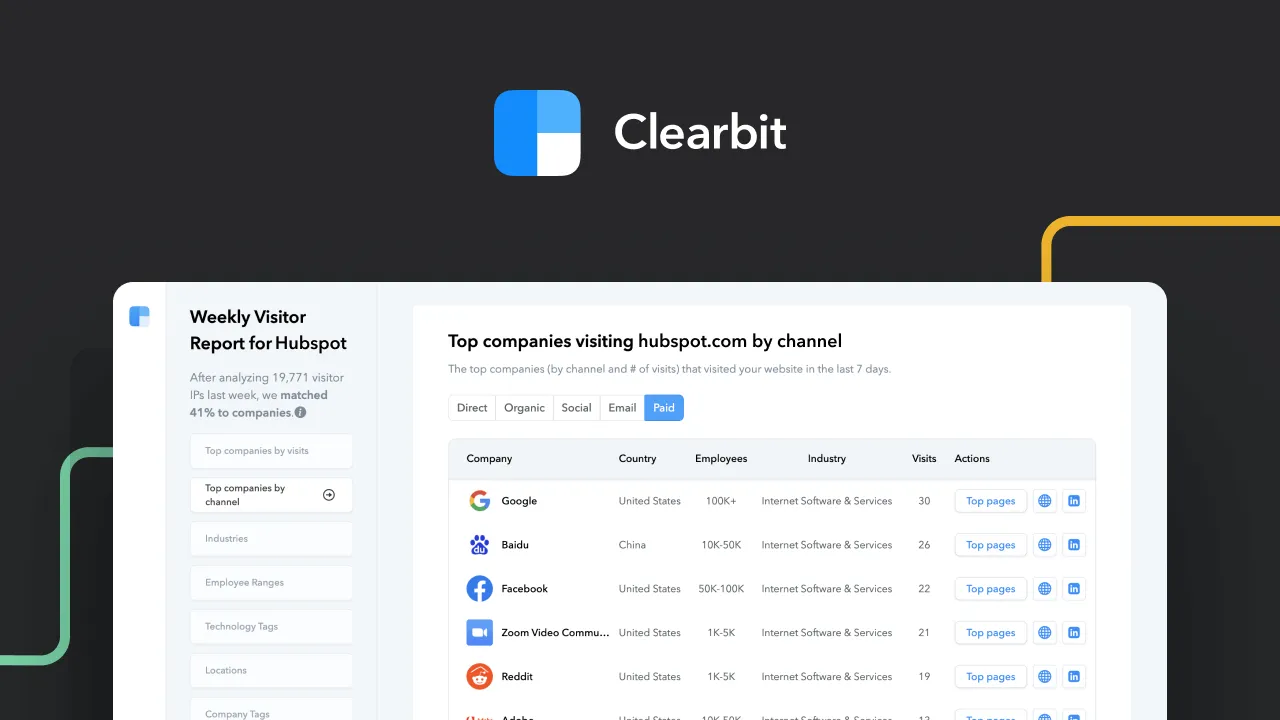
What it is: Lead enrichment tools find the missing pieces of your prospect lists or CRM contacts. They do that by crawling the web and building databases of job titles, email addresses, phone numbers, etc.
Some enrichment tools will go even further, providing information like what technology a prospect uses, company revenue, funding history, headcount, etc. This is especially useful for those who do account-based sales, where you need to focus on specific attributes.
When you connect your CRM or prospect list to the lead enrichment tool, it will compare your existing contact lists against their known information.
Why you need it:
- Flesh out the demographic and firmographic data of your contact lists.
- No more scouring the web to try to find contact information.
- Helps identify key decision makers.
Good vs. Great: Good enrichment tools will update their database regularly. Great enrichment tools connect to your CRM to automatically update your contact lists regularly.
Examples
4. Call Tracking and Call Analytics
.webp)
Get HubSpot’s Call Tracking Tool
What it is: Call tracking and analysis tools record, transcribe, and gather data about your sales calls. And we don’t just mean basic data like call length or frequency. These tools gather deeper data, like marketing sources, campaigns, and channels.
They analyze the transcripts to allow you to search calls by keyword, flag comments for training, and identify sales trends.
But their use isn’t just in looking backward. You can also use this data to prioritize your upcoming calls and turn them into an actionable calling queue by comparing prospects against your call data.
Why you need it:
- Prioritize your call queue by likelihood to convert.
- Automatically generate transcriptions for quality and training purposes.
- Filter, sort, and search for phone calls by keyword.
- Create sales reports based on calling data.
Good vs. Great: Good call-tracking tools record your calls and their associated data. Great call-tracking tools use AI to analyze the recordings and data to turn them into actionable insights.
Examples
- HubSpot Call Tracking (included in Sales Hub Starter or above)
- CallRail
5. Outreach/Email Platforms
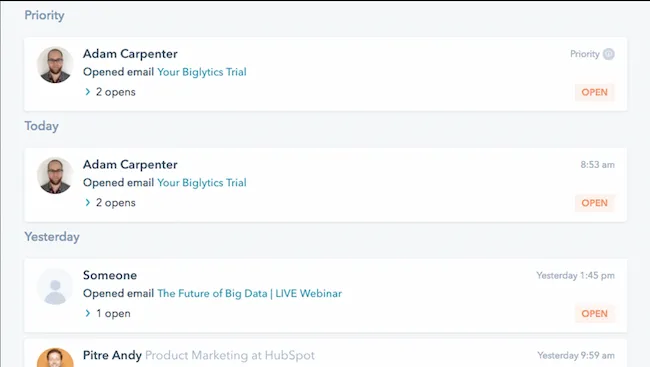 Get Started With HubSpot’s Email Tools
Get Started With HubSpot’s Email Tools
What it is: Outreach tools help in two ways: 1) automating the most tedious parts of emailing and 2) providing reporting so you can base your outreach on data-driven decisions.
In the first case, they offer tools like email scheduling, automated follow-up, and template personalization. These let you skip the manual labor without sacrificing the human element that separates sales from spam.
Second, they track important data like open rates, click-through rates, rejection rates, etc. This allows you to A/B test your email campaigns, so you can replicate your wins and learn from your losses.
Why you need it:
- Never forget to follow up with automated workflows.
- Scale your outreach with templates that can be personalized.
- See which subject lines, body text, and CTAs drive results.
Good vs. Great: Good email tools let you automate replies and follow-ups. Great email tools allow you to curate automated workflows based on your prospect’s behavior.
Examples
- HubSpot Email Marketing (included in Marketing Hub free or above) and Email Tracking (included in Sales Hub free or above)
- Buzzstream
6. Scheduling Tools
.webp)
What it is: Rather than emailing back and forth or playing phone tag t, scheduling tools make this process seamless.
You set your availability (or integrate it with your work calendar), and your prospects can then choose a time that works for them.
This way, prospects make appointments that work with their schedules, on their time, without any hassle. Meanwhile, reps can focus on other tasks and prep for their meetings with prospects.
Why you need it:
- Eliminates the back-and-forth dance of trying to find a time that works for everyone.
- Reduces friction for getting prospects to agree to a meeting or demo.
- Coordinates availability across team calendars.
- Round-robin scheduling based on sales rep availability.
Good vs. Great: Good scheduling apps allow you to choose your availability. Great scheduling apps sync with Office 365 or Google Calendar, so your work schedule is always up to date.
Examples
- HubSpot Meeting Scheduler (included with HubSpot free or above)
- Calendly
7. Video Chat and Screen-Sharing Tools
.webp)
What it is: For sales, video chat is the next best thing to in-person meetings. It’s faster than emailing and offers more connection than a phone call.
Many video chat services also include screen-sharing features, which allow you to give live demos and slide presentations. You can also use it to co-browse with potential customers as they shop.
Oftentimes, these tools will allow you to record video chats or screen-sharing sessions. This is great for training and performance review.
Why you need it:
- Increase face-to-face interaction with your leads and customers.
- Give live demos and presentations in real time.
- Co-browse with leads for added personalization.
Good vs. Great: Good video chat tools let you share links so your prospect can easily join. Great video chat tools allow you to seamlessly shift from email, chat, or phone to a video experience.
Examples
8. Live Chat
What it is: Live chat tools provide a chat window on your website or app, where customers can contact a sales agent in real time.
That’s a big deal when 82% of consumers consider an immediate response as important to sales questions.
Many chat tools can be customized to route messages to the right team or rep. If there are no agents available, most chat tools also offer the ability to trigger automated messages or even AI chatbots.
Why you need it:
- Offer real-time sales support to customers who don’t want to call.
- Gives a seamless jump from your website or app to a sales agent.
Good vs. Great: Good chat tools notify available agents of incoming messages. Great live chat tools send your messages to a universal inbox where you can also view emails, texts, and social messages.
Examples
- HubSpot Live Chat (included in HubSpot free or above)
- Zendesk Support Suite
9. Sales Reporting Software
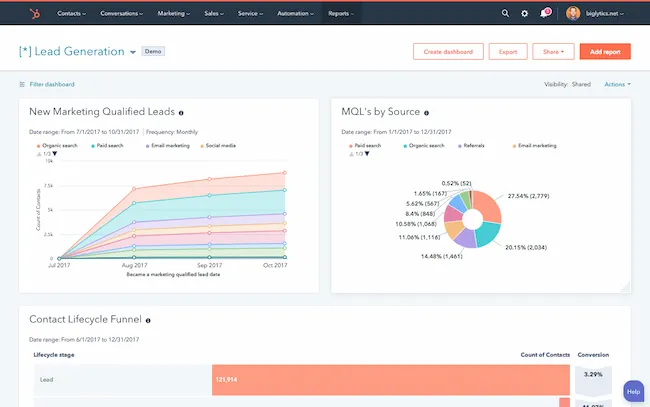 Get HubSpot’s Sales Reporting Software
Get HubSpot’s Sales Reporting Software
What it is: Accurate data helps you make accurate decisions. Sales reporting tools help you gather, organize, interpret, and visualize that data.
Different tools may pull different types of data, so consider the needs of your organization. For example, an inside sales team may need to track different KPIs than an outside sales team.
At the most basic level, reporting tools will gather simple metrics like revenue, response time, cost per lead, etc. More robust reporting software can turn those numbers into deeper insights — such as weighted forecasts, pipeline tracking, deal velocity, etc.
Why you need it:
- Identify pain points in your sales process.
- Replicate successful campaigns and strategies.
- Allocate budget and labor based on accurate sales forecasts.
- Prove ROI to your stakeholders.
Good vs. Great: Good reporting software will cover all the necessary sales KPIs. Great reporting software will let you customize your KPIs, sales funnel, channel attribution, and reports.
Examples
- HubSpot Sales Tracking Software (included in Sales Hub free or above)
- Looker Sales Analytics
10. Project Management Tools
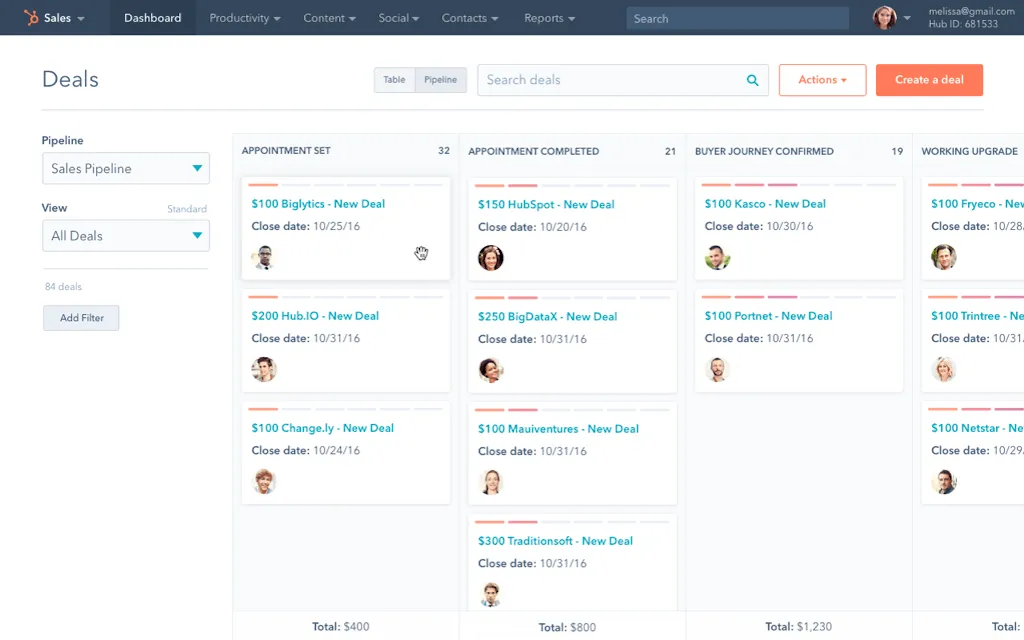 Get HubSpot’s Project Management Tool
Get HubSpot’s Project Management Tool
What it is: If you’ve outgrown a simple to-do list, project management software is the next step. These tools help you plan and assign tasks, set deadlines, and track your progress.
This is especially helpful for account-based sales teams, who may need to collaborate on closing deals.
These tools also give sales managers insight into productivity, time management, and project velocity.
Why you need it:
- Organize all projects and tasks in one central location.
- Collaborate on tasks with shared comments, assets, and timelines.
- Track work hours with project reporting.
Good vs. Great: Good project management tools offer customizable task creation and to-do lists. Great project management tools automate task creation and to-do lists, so you’re always up to date.
Examples
One of the best ways to discover the right sales tools for your team is by doing your homework. Want to see some of the top options? Check out this post for a comparison of 29 of the most popular sales tools.
Grow Better With the Right Inside Sales Technology
Keep in mind that while many sales tools have similar features, each has a unique spin. Some will work better with your brain — and your business, so don’t be afraid to experiment with different technologies to decide the right one for you.
To that end, while you might discover a combination of technologies is the right solution, you may also find that a single tool is all you need. Many times, a good CRM incorporates most of the tools in this list. So, begin growing better today by determining which technology your sales team needs to support their efforts.
Sales Automation


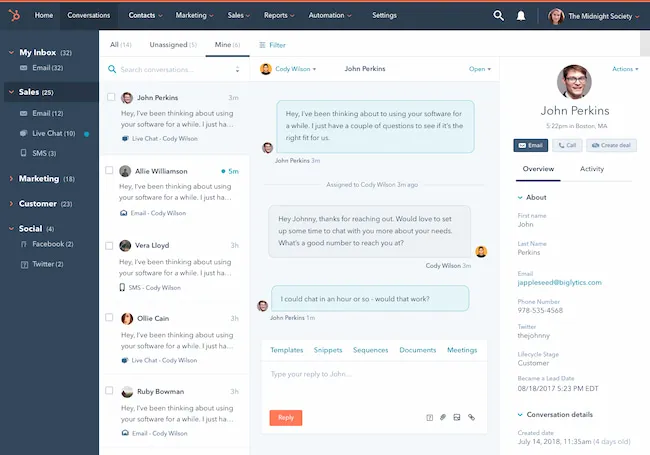 Get HubSpot’s Live Chat Tool
Get HubSpot’s Live Chat Tool

![How to Create Successful Email Drip Campaigns [Examples + Best Practices]](https://53.fs1.hubspotusercontent-na1.net/hubfs/53/71_Drip%20Campaign%20Emails.png)



.jpg)



![17 Tips to Get Sales Leads to Convert Faster [Infographic]](https://53.fs1.hubspotusercontent-na1.net/hubfs/53/00-Blog_Thinkstock_Images/alarm-clock-gold-hands-of-a-clock-1778-636510-edited.jpg)